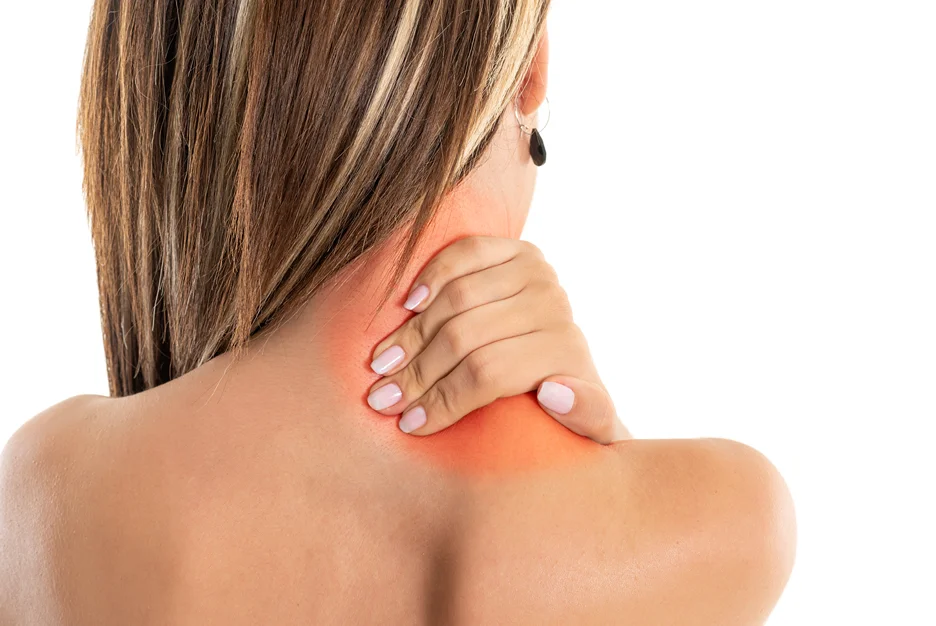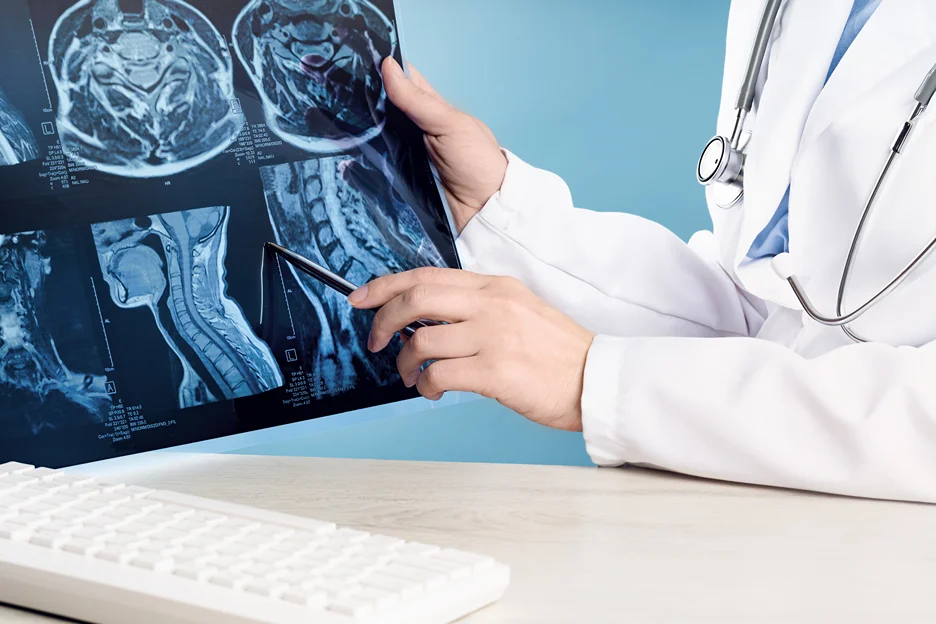Understand the Causes, Get Diagnosed, and Discover the Best Treatments
If you’re suffering from neck pain that radiates into your shoulders and arms, you may have a herniated disc in your neck. Herniated discs can cause debilitating pain, numbness, and weakness. But there are many ways to find relief.
In this comprehensive guide, we’ll walk you through everything you need to know about herniated discs in the neck, from causes and symptoms to diagnosis and treatments.
You’ll also learn effective exercises and lifestyle changes to manage pain and prevent future injuries. Let’s start by understanding exactly what is causing the pain.
Herniated Disc Neck Pain and its Symptoms

A herniated disc in the neck, also known as a cervical herniated disc or cervical disc herniation, can cause neck and arm pain. Some common symptoms include:
- Neck pain that may radiate to the shoulder blades
- Pain between the neck and shoulder blade
- Numbness, tingling or weakness in the arm or hand
- Deep pain near or over the shoulder blade
- Muscle spasms in the neck
The pain may be dull, aching or sharp and electric-like. It often worsens with neck movements like turning the head or bending the neck. The herniated disc can compress the spinal cord or spinal nerves in the neck, leading to these symptoms.
What Causes This Condition?
A herniated disc in the neck, known as a cervical herniated disc, is a common source of neck pain that can radiate into the shoulders and arms. This painful condition occurs when the soft inner material of a spinal disc ruptures through the outer layer and presses on the nerves of the spinal cord.
There are several factors that can lead to a herniated cervical disc:
| Factors | Description |
| Degenerative disc disease | As we age, the spinal discs lose hydration and elasticity, which makes them more prone to tears and ruptures. Years of wear and tear can cause discs to weaken and herniate. |
| Repetitive stress on the neck | Activities that place excessive strain on the cervical spine over time, such as heavy lifting or prolonged poor posture, can increase the risk of a disc herniation. The constant strain leads to microtears that can eventually cause the disc to rupture. |
| Traumatic injury | Sudden trauma to the neck from events like car accidents, sports injuries, or falls can tear or rupture discs. Forceful twisting or impact to the cervical spine can damage discs. |
| Pre-existing spinal conditions | People with arthritis, spinal stenosis, or other degenerative conditions of the spine are more likely to develop a cervical herniated disc. These conditions weaken and thin the protective discs over time. |
When a disc herniates in the neck, the inner disc material can press directly on spinal nerves, leading to symptoms like arm pain, numbness, and tingling.
While mild herniations may heal with rest and therapy, severe herniations may require spinal injections or surgery to relieve nerve compression and alleviate pain and symptoms.
Getting Diagnosed and Finding the Right Treatment

If you suspect you may have a herniated disc in your neck, it’s important to see a doctor for an accurate diagnosis and appropriate treatment recommendations. Here’s what you can expect:
- Your doctor will ask about your symptoms and medical history and conduct a physical exam of your neck. They will check your reflexes, muscle strength, range of motion, and look for areas of numbness or tingling.
- You may be referred for imaging tests like an MRI or CT scan to get a closer look at your cervical discs and nerves. This can help confirm if a disc is herniated and pinching nerves.
- In some cases, electromyography (EMG) may be used to measure nerve impulses and check for nerve damage.
- Your doctor will determine the best treatment plan based on your symptoms, exam findings, test results, and severity of the herniated disc. Most mild cases can be treated conservatively with rest, medication, therapy, and injections.
- If those options fail to provide relief after several weeks or months, surgery may be recommended to repair or remove the damaged disc. Talk to your doctor about the pros and cons of surgery for your situation.
You Deserve Answers – Connect with Experts to Diagnose Your Neck Pain. Sign Up for Kaly Today!
How to Address Cervical Disc Pain At Home
If you have neck pain from a herniated cervical disc, there are several at-home treatments that may help provide relief.
First, get plenty of rest and avoid activities that cause pain to allow time for healing, usually around 6 weeks. Applying ice packs to the painful area can help reduce inflammation.
Over-the-counter pain medications like ibuprofen are also useful for pain and inflammation relief. Physical therapy exercises tailored for your condition by a therapist can strengthen neck muscles and improve flexibility.
For some cases, injection therapies administered by a doctor, such as epidural steroid shots, may help reduce pain. For more severe or chronic pain, options like radiofrequency ablation or surgery could be considered, so see a spine specialist for evaluation and treatment recommendations.
Lastly, lifestyle changes like maintaining proper posture and lifting objects carefully can aid in preventing future cervical disc pain.
Exercises and Stretches to Try at Home
While resting your neck initially is important, light stretching and exercises can help strengthen your neck, improve mobility, and prevent future injuries. Here are some options to try:
| Exercise | Instructions |
| Chin tucks | Tuck your chin in gently without tilting your head forward. Hold for 5 seconds. Repeat 10 times. |
| Side neck stretches | Gently tilt your ear toward your shoulder. Hold 5 seconds. Switch sides. Repeat 2-3 times per side. |
| Shoulder rolls | Roll shoulders up and back in a circular motion 5 times. Then reverse direction. |
| Isometrics | Apply gentle pressure back into a wall with the back of head. Hold for 5-10 seconds. |
| Cervical extension | Look up at the ceiling, holding 5 seconds. Return to neutral. Repeat 5-10 times. |
| Upper trap stretches | Gently pull down on one shoulder with the opposite hand. Hold 15 seconds. Switch sides. |
Start slow with just a few reps of each exercise. Stop any activity that aggravates your pain. Consulting a physical therapist can ensure you receive a tailored exercise program for your needs and abilities.
Pursuing Medical Treatments

Along with self-care, your doctor may recommend certain medical treatments to help manage your cervical herniated disc and relieve symptoms:
Prescription Medications
Muscle relaxers like cyclobenzaprine or tizanidine can help relieve muscle spasms and pain associated with a cervical herniated disc. Stronger prescription painkillers like tramadol or hydrocodone may provide short-term pain relief as well, but should be used cautiously due to risks of dependency.
Cervical Epidural Steroid Injections
A steroid medication like cortisone is injected into the epidural space around the spine. This can decrease inflammation that is putting pressure on irritated spinal nerve roots, providing localized pain relief. Multiple injections may be given for ongoing relief.
Trigger Point Injections
Also known as intramuscular stimulation, a local anesthetic is injected directly into tense, painful muscle knots (trigger points). This provides short-term numbness and pain relief in those areas. Physical therapy is often recommended afterwards.
Radiofrequency Ablation
Using x-ray guidance, a probe with a heated tip delivers radiofrequency energy to disrupt nerve signaling from specific cervical nerves. This can “turn down” pain signals for many months at a time. Several sessions may be needed for sustained benefit.
Anterior Cervical Discectomy and Fusion (ACDF)
This surgical procedure removes the damaged cervical disc and fuses the vertebrae together to stabilize the segment. An implant may support the vertebrae as they heal into one solid bone. Recommended when non-surgical options do not provide sufficient pain relief.
A study published in the Evidence-Based Spine-Care Journal shows that ACDF had a mean improvement of pain of at least 50% approximately 4-years following surgery.
Cervical Disc Replacement
This involves surgically implanting an artificial disc in place of the damaged disc, maintaining neck mobility. May be an alternative to ACDF fusion for some patients. Long-term efficacy is still being researched.
Managing Cervical Disc Herniation Takes Expertise – Consult with Qualified Specialists on Kaly for Personalized Care Recommendations
How to Prevent Further Disc Damage
Along with treatments for your current pain, it’s wise to make lifestyle changes to help slow the progression of disc degeneration and prevent future herniations.
Here are some tips:
- Maintain proper posture and neck positioning during daily activities. Avoid hunching over or craning your neck forward.
- Limit activities that jar or vibrate your neck, like contact sports.
- Build muscle strength through regular exercise. Strong neck and back muscles help support your spine.
- Manage your weight to avoid putting extra strain on neck discs.
- Quit smoking, which is linked to faster disc degeneration.
- Modify your workstation ergonomics like monitor height and desk setup.
- Use good lifting techniques – keep your chest up and bear the load with your legs.
- Treat underlying conditions like arthritis that can contribute to cervical disc damage.
Small adjustments to your lifestyle and habits can go a long way in extending the healthy lifespan of your cervical discs.
Know When to See a Doctor
Most cases of cervical disc herniation can be managed with conservative treatments. But in some cases, you should seek prompt medical care:
- If pain, numbness or weakness in your arms becomes severe or disabling
- If you have difficulty with coordination or walking
- If you experience loss of bladder or bowel control
- If pain persists or worsens despite several weeks of treatment
- If symptoms are significantly impacting your daily activities and quality of life
Seeing a spine specialist for an evaluation can help determine if your herniated disc requires more aggressive treatment. Don’t hesitate to ask your doctor about your options.
Find Relief for Herniated Cervical Discs

We hope this guide gave you a better understanding of what causes neck and arm pain from a herniated cervical disc. With proper diagnosis and a combination of treatments tailored to your situation, most patients find significant relief.
Don’t give up if one therapy doesn’t work – finding the right option or combination may take some trial and error.
At Kaly, our connected care platform allows you to easily find spine specialists, physical therapists, pain management doctors, and other healthcare professionals experienced in treating cervical herniated discs.
Join for free today to access top-rated chronic pain providers near you. We’re here to help you finally find lasting relief!
